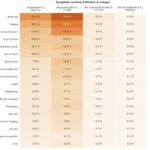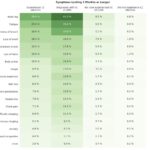By Catherine Weldon and Stella Aslibekyan, Ph.D.*
In what is among the largest studies of long COVID to date, researchers at 23andMe confirm that it disproportionately impacts women, and being diagnosed with depression or anxiety is associated with a more than a two-fold increase in risk for the condition. The study also found that about half of those with persistent symptoms are experiencing them for six months or longer.
Even after a year, more than 10 percent of those who reported being diagnosed with long COVID continue to have symptoms like brain fog, fatigue, and shortness of breath. It’s important to note long COVID refers to individuals who have health effects that linger weeks, months, or longer after COVID-19 infection.
In regression analyses controlling for age, sex, and ethnicity, 23andMe researchers found that those who reported that they had depression or anxiety prior to COVID-19 infection had a two-fold increase in the risk of being diagnosed with long COVID, and having a cardiometabolic disease was associated with a 90 percent higher risk of being diagnosed. Cardiometabolic diseases include conditions such as high blood pressure, coronary artery disease, type 2 diabetes, and high cholesterol.
23andMe data also indicate that more than half of the participants saw no difference after vaccination. Of those who did see a difference, approximately twice as many people reported improvement rather than worsening of some or all symptoms.
Confirms Some Previous Findings
Preliminary data from the unpublished study indicates that women are at least twice as likely to be diagnosed with long COVID compared to men even when controlling for age, ethnicity, and related health conditions. This contrasts with the overall breakdown of those infected with COVID-19, where men are much more likely to be infected than women. Men are slightly more likely to die from the virus as well, according to a recent Harvard study.
The 23andMe study data is also consistent with other studies that have found women are much more likely to develop long COVID. More than 78 percent of those diagnosed with long COVID in the study were females, compared to about 62 percent among those who reported not having experienced long COVID. The findings in our study are aligned with other studies, including a study led by researchers at the University of Milan that found that women were more than three times as likely to develop long COVID than men.
23andMe’s data also indicated that when compared with men, a larger percentage of women with long COVID appear to have symptoms that persist a bit longer, which is also consistent with other smaller studies. In addition, long COVID disturbs menstrual cycles; according to 23andMe’s data, about a quarter are reporting that they are still dealing with disruptions after a year.
Beyond the disproportionate impact on women, those who have had the most severe cases of COVID are also at a much higher risk of developing long COVID. In the 23andMe study, researchers found that individuals with COVID who required hospitalization had a more than ten-fold risk of being diagnosed with long COVID compared to those who were not hospitalized when controlling for age, sex, and ethnicity.
Very Large Study Cohort
Scientists still don’t understand what causes long COVID, nor how to best treat it. An effort to recruit patients to study the condition by the National Institutes of Health got off to a slow start, with the agency only recruiting about 1,300 people by late March, far short of their 40,000-patient goal.
The 23andMe study included data from more than 100,000 individuals who reported contracting COVID-19. Of those included in this study, more than 26,000 reported that they had experienced long COVID, and over 7,000 said they’d been diagnosed with it. This unpublished study is part of a series of studies being conducted by 23andMe scientists since the beginning of the pandemic in 2020.
Among the areas of study is research on the role blood type plays in severity and susceptibility to the virus, and insights into the genetics that influence different reactions to COVID-19 vaccines. Earlier this year, 23andMe published a study in the journal Nature Genetics that identified genetic variants associated with the loss of smell or taste due to COVID-19. That paper offers more detail on the study, which identified variants near two olfactory genes — UGT2A1 and UGT2A2.
Long-Haulers and Sex Differences
This latest study is part of an effort to better understand the so-called long haulers: individuals with health effects that linger weeks, months, or longer after COVID-19 infection.
Why do some individuals continue to have symptoms long after the initial infection? Why are women more likely to develop long COVID than men, and what is the role of genetics in this?
While the 23andMe researchers found no genetic variants associated with developing long COVID, the higher rate of cases in women may be indicative of differences in hormonal levels, which are substantially rooted in genetics.
The sex differences do suggest biological underpinnings and can help elucidate them.
Scientists know there are similar differences for other kinds of conditions. For example, women are much more likely than men to develop autoimmune conditions such as lupus or multiple sclerosis. Autoimmune conditions occur when the body’s immune system misfires and attacks healthy cells in the body. Females typically have two copies of the X chromosome, which has the largest number of immune-related genes. That in turn means that different immune responses are more pronounced in women.
Whether this explains the much higher incidence of long COVID in women has yet to be determined. But 23andMe researchers did find that about a third, or 32 percent, of those diagnosed with long COVID had some sort of autoimmune disease, compared to only about 20 percent among those who reported not having experienced long COVID.
Serious Symptoms
- Among the largest long COVID studies to date using self-reported data from more than 100,000 individuals consented to participate in research.
- Females are more than twice as likely to be diagnosed with long COVID compared to males when controlling for age, race/ethnicity, and related health conditions.
- Long COVID Symptoms linger past 12 months among at least 10 percent of those with long COVID.
- More than half of those with Long COVID had a history of depression, anxiety, or cardiometabolic disease prior to COVID-19 infection.
- Having a history of depression or anxiety was associated with more than a two-fold increase in the risk of being diagnosed with Long COVID.
- Having a cardiometabolic disease is associated with an approximately 90% higher risk of being diagnosed with long COVID.
- About a third of those who develop Long COVID have an autoimmune disease.
- More than half of the participants saw no difference in symptoms after vaccination. Of those who did, almost twice as many reported improvement in symptoms compared to those who reported worsening symptoms.
- Hospitalization for COVID led to a ten-fold increase in the risk of being diagnosed with long COVID.
- This unpublished study is part of a series of studies being conducted by 23andMe scientists since the beginning of the pandemic in 2020.
Although trend lines are pointing downward for infections, hospitalizations, and deaths due to COVID-19, the impact of long COVID remains unknown. The condition is thought to affect as many as 30 percent of those who are infected with the virus.
23andMe’s study found that symptoms lasted from three months to more than a year, with some individuals continuing to suffer. The top symptoms– which the participants reported arose only after the COVID-19 infection– were brain fog, fatigue, and shortness of breath.
Among those diagnosed with COVID-19, even at six months about 34 percent of those diagnosed with the condition reported an inability to focus or concentrate associated with what’s termed “brain fog.” After a year, about 19 percent still had brain fog. After 12 months, about 14 percent reported having shortness of breath, and about 7 percent said they had heart palpitations.
What’s Next
There are a few limitations to our study that we should note. For one, this study relies on self-reported data from 23andMe consented research participants. As with other studies on long COVID, the diagnosis is still nebulous and highly variable, and the reports can be subjective. We include both information from those participants who reported that they were diagnosed with long COVID or simply reported that they had long COVID.
Another important consideration is that 23andMe’s data is not representative of the U.S. population as a whole. That said, the prevalence of various symptoms is similar to that in the published literature.
Future studies are warranted to continue documenting the natural history of long COVID over longer time periods. In addition to corroborating our findings, it is possible that future studies of even larger populations will find some genetic underpinnings of the reported symptoms, although the individual effect of each genetic factor is likely to be small.
As people continue to deal with symptoms of long COVID, using studies like ours to better understand the illness will be increasingly important. Projecting over the millions of individuals worldwide who’ve been infected or are yet to be infected, the public health impact of long COVID is likely to linger for years to come. Understanding the underlying biology and associations may help as scientists wrestle with the best way to treat the condition.
*Catherine is an associate scientist at 23andMe and Stella is a genetic epidemiologist at 23andMe.
Editor’s note: Throughout this post we use the word women for simplicity, but the study was actually based on anyone with XX chromosomes. So “women” in our study may include people whose gender identity is different than the sex they were assigned at birth.







